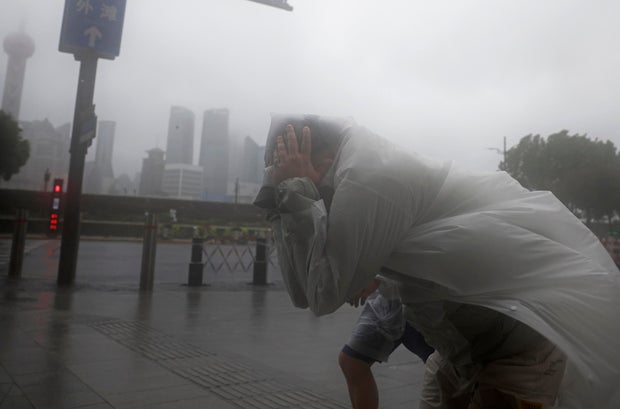Taipei, Taiwan — The strongest typhoon to hit Shanghai since at least 1949 flooded roads with water and broken tree branches, knocked out power to some homes and injured at least one person as it swept over the financial hub Monday. More than 414,000 people had been evacuated ahead of Typhoon Bebinca’s arrival with powerful winds and torrential rain. Schools were closed and people were advised to stay indoors.
One elderly man was injured by a falling tree on Shanghai’s Chongming Island, according to state media. He was taken to a hospital for treatment.
Typhoon Bebinca made landfall around 7:30 a.m. in the sprawling Pudong business district with winds of 94 mph near its center. Torrential rains flooded roads in the district, according to images broadcast by state media. Elsewhere in Shanghai, uprooted trees and fallen branches blanketed some roads and sidewalks.
Yin Liqin/China News Service/VCG/Getty
As the typhoon eased, responders cleared branches and other objects blown around by the storm.
More than 60,000 emergency responders and firefighters were on hand to lend aid in Shanghai.
Authorities said winds uprooted or damaged more than 10,000 trees and knocked out power to at least 380 households, damaging four houses.
At least 132 acres of farmland were flooded.
The typhoon weakened as it moved inland, dousing parts of Jiangsu, Anhui and Zhejiang provinces.
Flights, ferries and train services had been suspended in the megacity and in neighboring provinces, disrupting travel during China‘s three-day Mid-Autumn Festival. Shanghai’s airports canceled hundreds of flights Sunday and into Monday, while in Hangzhou, about 106 miles southwest of Shanghai, authorities also canceled more than 180 flights.
Flights at Shanghai’s airports resumed Monday afternoon as the storm moved away.
Weather authorities expected Shanghai and parts of neighboring provinces to receive up to 12 inches of rainfall between Monday and Wednesday.
Shanghai, which has 25 million people, is rarely hit by typhoons, which usually make landfall further south in China.
Typhoon Yagi hit China’s southern Hainan island earlier this month and has caused devastation in Southeast Asia. In Myanmar, Yagi caused at least 74 deaths with dozens missing. Four deaths were reported in Hainan, at least 10 have died in Thailand and 20 in the Philippines. Vietnam has reported more than 230 people killed in the typhoon and subsequent flooding and landslides, with dozens more still missing.
Before that, Typhoon Shanshan weakened to a tropical storm before it hit Japan, but it still brought torrential rains that snarled travel and was blamed for at least a handful of deaths.
Storms like Typhoon Bebinca are getting stronger and less predictable due to climate change, primarily because warmer oceans provide more energy to fuel the severe weather, according to climatologists.
#Typhoon #Bebinca #slams #Shanghai #China #sparking #evacuation #people

